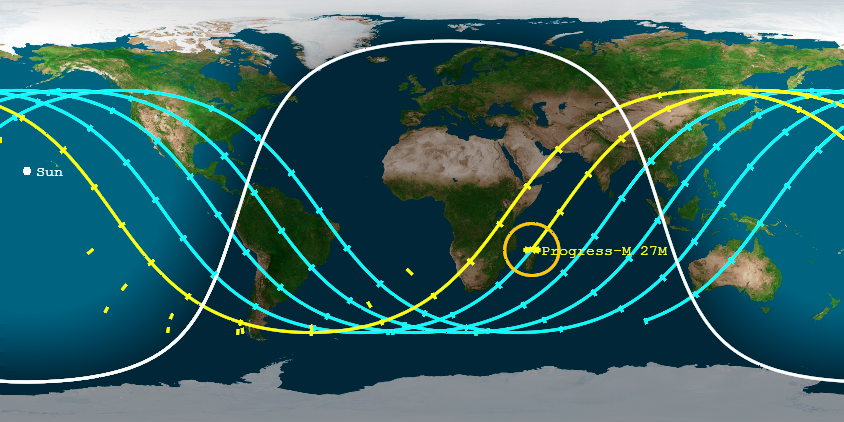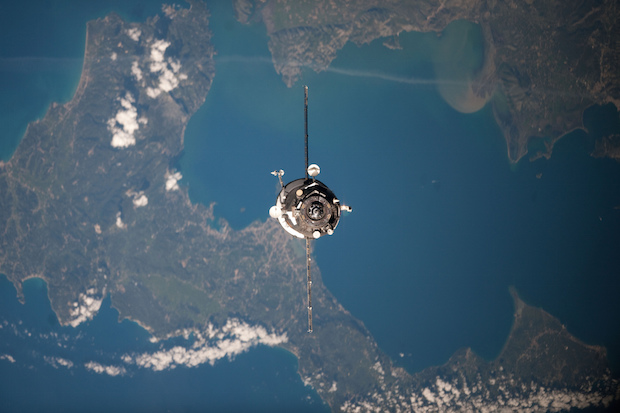UPDATES SEEM TO PLACE REENTRY (OF WHATEVER DOES NOT BURN UP IN THE ATMOSPHERE) SOMETIMES FRIDAY, MAY 8, 2015, BUT I DID NOT DETERMINE WHICH SIDE OF THE INTERNATIONAL DATELINE THAT PREDICTION MEANS...FRIDAY IN THE U.S. WILL BE SATURDAY ELSEWHERE.
HERE ARE CURRENT ORBITAL PATHS:
A sample of the Progress M-27M spacecraft’s ground track shows its orbital path around Earth. Credit: Aerospace Corp.
THE LAUNCH OF THE RUSSIAN 'PROGRESS M-27M' CARGO SPACECRAFT, SEEN BELOW IN A PREVIOUS APPROACH TO THE INTERNATIONAL SPACE STATION (ISS), WENT AWRY ON APRIL 28, SPINNING OUT OF CONTROL BEFORE REACHING ITS PROPER ORBIT.
IT IS NOW ORBITING BELOW THE ORBIT OF THE ISS.
THE INTENDED RE-SUPPLY CARGO FOR THE ISS LIFTED OFF FROM KAZAKHASTAN ABOARD A SOYUZ ROCKET
AN EXCELLENT ARTICLE FROM "SPACEFLIGHT NOW"
[ http://spaceflightnow.com/2015/05/06/out-of-control-progress-cargo-craft-to-fall-back-to-earth/ ]
Video transmitted from a camera affixed to the supply ship showed it rotating once every five seconds, and Russian ground controllers gave up plans to dock the unmanned vessel to the space station.
Investigators are looking into the cause of the mishap, with attention focusing on the Progress spacecraft’s deployment from the third stage of its Soyuz rocket booster.
The first results of the inquiry are due May 13.
The Soyuz rocket deployed the Progress resupply freighter into an orbit below the space station, and the spacecraft will succumb to atmospheric drag without a way to boost its altitude.
The launcher’s depleted third stage fell back to Earth on April 29, and the Russian space agency — Roscosmos — said Wednesday it forecasts the Progress spacecraft’s re-entry will occur some time Friday.
Roscosmos predicted re-entry to occur in a nearly 21-hour window centered on 0839 GMT (4:39 a.m. EDT) Friday.
The website Space-Track.org, which uses U.S. military tracking data, gave a re-entry prediction of some time Thursday or Friday.
Another projection issued by the Aerospace Corp. on Tuesday indicated the Progress spacecraft would likely re-enter in a 36-hour period Friday or Saturday.
The disparities illustrate the difficulties in forecasting when unpiloted satellites and space junk will plunge back to Earth. Analysts can refine the margin of error closer to the expected re-entry time, but it is impossible to pinpoint where an object will come down.
As of Wednesday, the spacecraft was circling Earth at an average altitude of about 108 miles.
In a statement released Wednesday, Roscosmos said more precise information on the timing and location of the stricken spaceship’s re-entry would be available one day before the descent.
Roscosmos officials said the bulk of the Progress M-27M cargo ship, which is not fitted with a heat shield, will burn up during the scorching re-entry. Only a few fragments of the spacecraft sould reach Earth’s surface, according to the space agency.
The 7-ton Progress spacecraft, potentially still carrying a sizable amount of toxic fuel, orbits Earth at an angle of 51.6 degrees to the equator. Any debris that does fall will impact in a swath between 51.6 degrees north and south latitudes.
The capsule launched with more than 6,000 pounds of supplies, food and experiments for the space station and its six-person crew. The Progress carried dry goods inside a pressurized cargo module, plus tanks with water, air and propellant to refuel the space station.
Despite the capsule’s lack of a heat shield, supplies packed inside the Progress have a better chance of weathering the re-entry because high-temperature plasma must burn through the craft’s structure before reaching its interior, according to Ailor.
“Given the fact that material inside is somewhat protected during the early parts of re-entry, maybe somewhere 2,500 to 3,500 pounds of material might survive,” Ailor wrote in an email to Spaceflight Now. “Much of this material would itself be broken into smaller pieces and spread along a footprint several hundred miles long.”
The risk of the uncontrolled re-entry to the public is small, and no one has ever been injured from a manmade object falling from space. Most of Earth’s surface between 51.6 degrees north and south latitudes is ocean, and vast regions of most continents are unpopulated.
NASA says the space station astronauts are well-provisioned, and an accounting of the orbiting lab’s consumables shows the residents have enough food to last until early September, even without more cargo deliveries planned over the next few months.
At the end of Progress resupply missions, space station crews load the Russian cargo capsules with trash for disposal. After undocking, Russian ground controllers guide the vehicles to re-entry over the uninhabited South Pacific Ocean, away from land masses and heavily-trafficked sea and air corridors.
I HOPE THIS IS JUST A MINOR SETBACK.
MAY EVERYONE BE SAFE.
PERHAPS THERE WILL BE INCREDIBLE VIDEO OF THE CRAFT'S FIERY REENTRY.


No comments:
Post a Comment